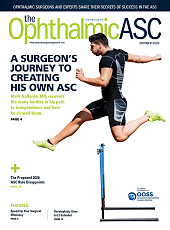For this month's Retina Minute, I have the pleasure of talking with my dear friend, Dr. David Eichenbaum, who is a collaborative associate professor of ophthalmology at Morsani College of Medicine at the University of South Florida.
Recently at EURETINA, Dr. Eichenbaum, you presented fascinating data on the use of artificial intelligence (AI) in macular degeneration (AMD). Can you explain the process and what you found?
The promise of large population research with AI is profound. The problem with existing data in real-world studies is there is a lot of information out there, but it is only from smaller data sets. We have reviews of dozens to 100 or 200 eyes, and we look at 1, or maybe 2 biomarkers. These data sets are not scalable, which means we must piece information together.
My talk at EURETINA was about structural biomarkers and predicting exudation or conversion to wet AMD from geographic atrophy (GA). Our goal was to explore the potential of AI in prospective work, if this retrospective data is valid and can be duplicated. We wanted to look at tremendous groups of patients and as many biomarkers as possible which may impact the risk of exudation in GA. With AI, you have a teachable model with profound processing power into which you can input millions of images and dozens of biomarkers, and you can pick and choose what you want to analyze. AI output is endlessly customizable because of its massive processing power and its ability to change the output in real time as you add or subtract from it.
The system in this study, Amaros’ Evidence Engin, is an example of one of several burgeoning AI programs or processing environments that are similar at a high level. Of course, each operational and preoperational AI program has its own individual and differentiating factors. What makes this platform unique is not only that it takes images, electronic health records (EHRs), and claims, but it can also harmonize data across many disparate imaging and EHR platforms. A lot of other production AI platforms exclusively look at either Heidelberg or Heidelberg and Cirrus, but this platform can harmonize multiple different color, optical coherence tomography (OCT), autofluorescent, and fluorescein images and extract data from their disparate inputs.
We can take those harmonized inputs and look at them across preprogrammed biomarkers, which Amaros has validated against reading center assessments for drusen, for example. We can then generate data from the many, many images in the system.
Tell us about the study.
We programmed the Amaros Evidence Engine with images from 90 retina clinics and looked at almost 37,000 eyes from those clinics based on the diagnosis code for GA and clinic imaging. We told the program to look only at eyes that had criteria that were similar to GATHER, OAKS, and DERBY without choroidal neovascularization (CNV) at onset. We wanted to extract biomarkers from those eyes and see which ones predicted a conversion to neovascular AMD (nAMD).
To determine which eyes to focus on, we filtered those 37,000 eyes down to about 10,000 trial-eligible GA eyes, and then looked exclusively at eyes that had a new diagnosis of wet AMD, defined as either the presence of any retinal fluid or the initiation of antiangiogenics within the analysis timeframe. That process yielded 1,113 eyes. We input several biomarkers from the library into the program to see which ones had an increased hazard risk of converting to wet AMD in that group.
We looked at thickness-based biomarkers, volume-based biomarkers, and anatomic-spatial biomarkers all in OCT, as well as fundus autofluorescence—about 20 different biomarkers in total in that group of 1,113 eyes. We found 4 biomarkers that stood out retrospectively as significant predictors of conversion to nAMD: hyperreflective foci volume, inner retinal thickness, retinal pigment epithelium to drusen complex thickness, and presence of subretinal drusenoid deposits. GA size, pigment epithelial detachment volume, and the presence or absence of specific types of drusen other than subretinal drusenoid deposits were not significant predictors of conversion to wet AMD. They seemed to be signs that reflect chronic degeneration as opposed to imminent exudation.
Fascinating. Was there one that was the most likely to change or do you need a group of 2, 3, or 4, and how did your hazard ratio change based on the number of factors you have?
We looked at the biomarkers independently, so I do not have data on them being additive in a group, like you described, but the two that had the highest hazard ratio were a hyperreflective foci volume and the presence of subretinal drusenoid deposits. The increased risk for conversion was 1.2 to 1.3 times greater than if the eyes did not have hyperreflective foci volume or presence of subretinal drusenoid deposits.
How will this change your approach to treating patients who have these high-risk factors?
Clinically in 2025, if we see patients with many hyperreflective foci or subretinal drusenoid deposits in particular, it might be reasonable to bring them back sooner to check them, regardless of whether they are on complement modulation therapy. If they are on complement modulation therapy, I would be careful. My practice pattern in clinic is to get OCTs every time for patients who are on complement modulation therapy because of the increased risk of conversion to wet AMD with the complement modulators, but what I may do in patients who are not getting complement modulation therapy is bring them back more often.
I think what is more important and relevant for AI-type algorithms and programs than monitoring changes in clinic is enriching clinical trials with these types of patients. One of the pain points with complement modulating therapy is the risk of conversion to CNV, so I feel that if we want to study a population that is at a high risk for conversion to CNV with GA, we would enrich a clinical trial with these types of patients. You can find them in a potential population for a clinical trial relatively quickly by running their images through this type of program, and you could select for those patients for a trial, if you are looking to test an investigative product that is complement modulating and perhaps antineovascular, and want to look especially at the incidence of on-study CNV onset.
This is fascinating work and the potential seems enormous, but to your point about enriching clinical trial populations in the short-term, some physicians have theorized some clinical trials may have failed only because they picked the wrong patient as opposed to the drug failing. If we can enrich populations this way, do you think that it might bring new life to therapies that we have discarded?
I think it could accelerate how we enroll for certain therapies, or we can make much more targeted pushes for patients. We could look specifically for patients who have these particular criteria on imaging and find them relatively quickly. These are not things that you can find even if you are manually chart sweeping and looking at pictures because that takes quite a long time. But if you want to find all the patients with GA and subretinal drusenoid deposits in your database, and you have a database that is accessible to this type of rapid processing, you just enter that biomarker, hit go, and the system will identify all those patients for you and then you can have much more targeted recruitment.
Of course, that must be tested prospectively in the real world to see if it works. That has not been done yet to my knowledge, but that is the potential that we are looking at.
With this increased risk of conversion to wet AMD, did you stratify the patients on whether they were receiving complement therapy?
Any of those 37,000 eyes that were on complement therapy were excluded from this analysis group. That was one of the reasons we filtered down to 1,113 eyes. We excluded all patients who had GA on treatment, preexisting nAMD, or GA but without characteristics that were close enough to GATHER, OAKS, and DERBY. Those patients were not in the analysis pool.
Was the GA diagnosis made based on imaging or coding, or based on autofluorescence?
The diagnosis of GA was obtained through the EHR and AI analysis of the imaging in these clinics that are connected to Amaros.
This paper has incredible implications to change the paradigm on how we mine for data and then using that data to create more targeted algorithms for both our studies and our drugs, so I really appreciate you sharing it with us and I am looking forward to seeing how this technology evolves to potentially help us be more precise in how we treat patients.
That is the hope.
Thank you, Dr. Eichenbaum. I am excited about the future of this tool.










